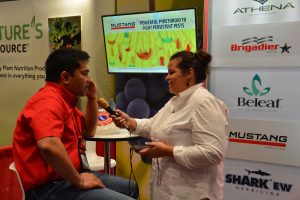“This is one of the most exciting times to be at FMC,” Kaustubh Borah, segment manager for specialty crops, told AgWired during the 42nd annual CAPCA Conference & Agri-Expo. With the acquisition of Cheminova, FMC’s fungicide portfolio has expanded. For instance, in the TF&V segment FMC now has some new fungicides along with some insecticides and herbicides to complement the entire portfolio.

FMC’s Kaustubh Borah speaks with AgWired’s Joanna Schroeder about their new fungicides Rhyme and Fracture during the 2016 CAPCA Conference.
FMC used CAPCA as the platform to launch two new fungicides. The first is Rhyme™ fungicide, which Borah says it is one of the most highly systemic triazoles in the marketplace. “What this basically means is that it translocates within the plant very quickly and helps to control some very difficult to control diseases such as powdery mildew, brown rot blossom blight and leaf rust.” Borah said they are also going to be getting a chemigation label to help their farmer customers use it through the drip. Borah also pointed out iprodione, Sovran® fungicide and mancozeb (Koverall® fungicide) as some other fungicide offerings complementing the portfolio.
FMC also has a new biological called Fracture® fungicide. I asked Borah how the fungicide works and how it differs from others on the market. He explained that the polypeptide is extracted from sweet lupine plants and it binds itself to the cell walls of the fungi and fractures it, hence the name Fracture. It then coats the fungal cell membrane covering it completely and then prevents the cell from absorbing nutrients thus suffocating it. Within four hours the cell cannot reproduce and within eight hours the cell is dead. “Fracture controls powdery mildew and botrytis. It has a 24 hour PHI and a four-hour REI,” said Borah.
In terms of how it stands out, Borah explained Fracture fungicide has multiple modes of action and it is so unique that Borah said a new FRAC Group, M12, had to be created for its active ingredient, BLAD. “So growers who want to practice good resistance management should use Fracture fungicide in their program.” He recommends rotating different classes of fungicides for resistance management and using Fracture fungicide in the rotation program to break the ‘cycle’.
Borah noted that if a grower keeps using the same mode of action, resistance is likely to develop. Fracture fungicide is a preventative material with some curative activity. He added that they expect the OMRI label in the first quarter of 2017, enabling organic growers the ability to use Fracture fungicide. He seemed excited that the organic growers would soon be able to use this effective fungicide in their program. The product is available in all TF&V markets across the country and is currently labeled on strawberries, grapes, tomatoes and almonds. It controls powdery mildew, botrytis and brown rot blossom blight. FMC is looking to add new crops and testing for control of additional diseases with Fracture fungicide. He reiterated FMC’s commitment to work with customers in understanding gaps and bring truly new innovative solutions to the market place.
To learn more about FMC’s expanding portfolio, listen to my interview with Kaustubh Borah here: [wpaudio url=”http://traffic.libsyn.com/zimmcomm/CAPCA16-fmc-borah.mp3″ text=”Interview with Kaustubh Borah, FMC”]
Be sure to check out even more action by viewing the 42nd Annual CAPCA Photo Album.
